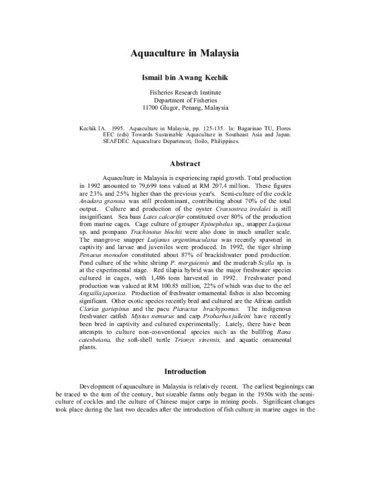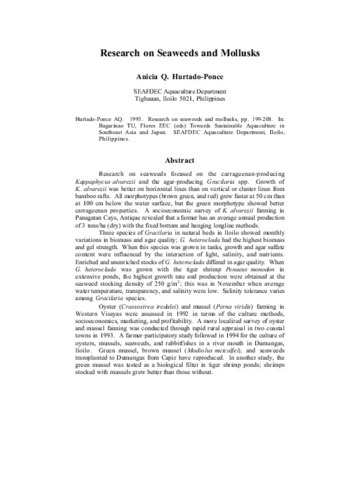Grow-out culture of oyster Magallana bilineata (Röding, 1798) using pouches: A comparison of growth and survival in the river and earthen pond
| dc.contributor.author | Lebata-Ramos, Ma. Junemie Hazel | |
| dc.contributor.author | Solis, Ellen Flor D. | |
| dc.contributor.author | Almeida, Mark Jude C. | |
| dc.date.accessioned | 2023-04-17T02:02:33Z | |
| dc.date.available | 2023-04-17T02:02:33Z | |
| dc.date.issued | 2023-03 | |
| dc.identifier.citation | Lebata-Ramos, Ma. J. H. L., Solis, E. F. D., & Almeida, M. J. C. (2023). Grow-out culture of oyster Magallana bilineata (Röding, 1798) using pouches: A comparison of growth and survival in the river and earthen pond. Philippine Agricultural Scientist, 106(1), 55-65. | en |
| dc.identifier.issn | 0031-7454 | |
| dc.identifier.uri | http://hdl.handle.net/10862/6426 | |
| dc.description.abstract | Oysters are among the most in-demand aquaculture commodities in the Philippines and worldwide. With the decreasing culture area and the deteriorating water quality of oyster beds, there is a need to explore new culture sites and techniques to address the problems of dwindling stocks and the increasing demand for better quality oysters. This study compared the growth and survival of the oysters Magallana bilineata, the new accepted name of Crassostrea iredalei, cultured in an earthen pond and the river using pouches suspended from rafts. Mean growth rates of oysters in length and weight were significantly higher in those reared in the river (0.56 ± 0.02 cm mo-1; 10.27 ± 0.42 g mo-1) than those in the pond (0.41 ± 0.03 cm mo-1; 5.99 ± 0.22 g mo-1), but the meat yield of oysters reared in the river (25.96 ± 0.92%) was almost the same as in the pond (24.05 ± 1.41%). Likewise, the proximate composition was the same for oysters coming from the river and the pond, respectively — 58.04 ± 0.14% and 53.86 ± 0.38% crude protein, 7.00 ± 0.08% and 7.93 ± 0.38% crude fat, 24.68 ± 0.07% and 28.54 ± 0.74% nitrogen-free extract, and 10.27 ± 0.01% and 9.68 ± 0.01% ash. Oyster survival at harvest was significantly higher in the river (70.21 ± 2.84%) than in the pond (13.10 ± 1.57%). However, with some interventions, ponds may still be utilized for oyster culture despite the low survival results in this study. Extending oyster culture in these aquaculture facilities may serve as a basis for interventions to make the pond more habitable for oysters and may help boost production in the country. | en |
| dc.description.sponsorship | The authors greatly appreciate the Aquaculture Department of the Southeast Asian Fisheries Development Center (SEAFDEC/AQD) for funding the study (Project Code FS-02-M2019T). | en |
| dc.language.iso | en | en |
| dc.publisher | College of Agriculture and Food Science, University of the Philippines Los Baños | en |
| dc.relation.uri | https://pas.cafs.uplb.edu.ph/download/grow-out-culture-of-oyster-magallana-bilineata-roding-1798-using-pouches-a-comparison-of-growth-and-survival-in-the-river-and-earthen-pond/?wpdmdl=2589 | en |
| dc.subject | Crassostrea iredalei | en |
| dc.subject.lcsh | Southeast Asian Fisheries Development Center. Aquaculture Department | en |
| dc.title | Grow-out culture of oyster Magallana bilineata (Röding, 1798) using pouches: A comparison of growth and survival in the river and earthen pond | en |
| dc.type | Article | en |
| dc.citation.volume | 106 | en |
| dc.citation.issue | 1 | en |
| dc.citation.spage | 55 | en |
| dc.citation.epage | 65 | en |
| dc.citation.journalTitle | Philippine Agricultural Scientist | en |
| dc.subject.asfa | oysters | en |
| dc.subject.asfa | pond culture | en |
| dc.subject.asfa | oyster culture | en |
| dc.subject.asfa | growth | en |
| dc.subject.asfa | survival | en |
| dc.subject.scientificName | Crassostrea iredalei | en |
| dc.subject.scientificName | Magallana bilineata | en |
| local.subject | Crassostrea iredalei | en |
| local.subject | Magallana bilineata | en |
| local.subject | oysters | en |
| local.subject | pond culture | en |
| local.subject | pouch | en |
| local.subject | SEAFDEC/AQD | en |
Files in this item
| Files | ขนาด | รูป | View |
|---|---|---|---|
|
There are no files associated with this item. |
|||
รายการนี้ปรากฏใน (s)
-
Journal Articles [1258]
These papers were contributed by Department staff to various national and international journals.



